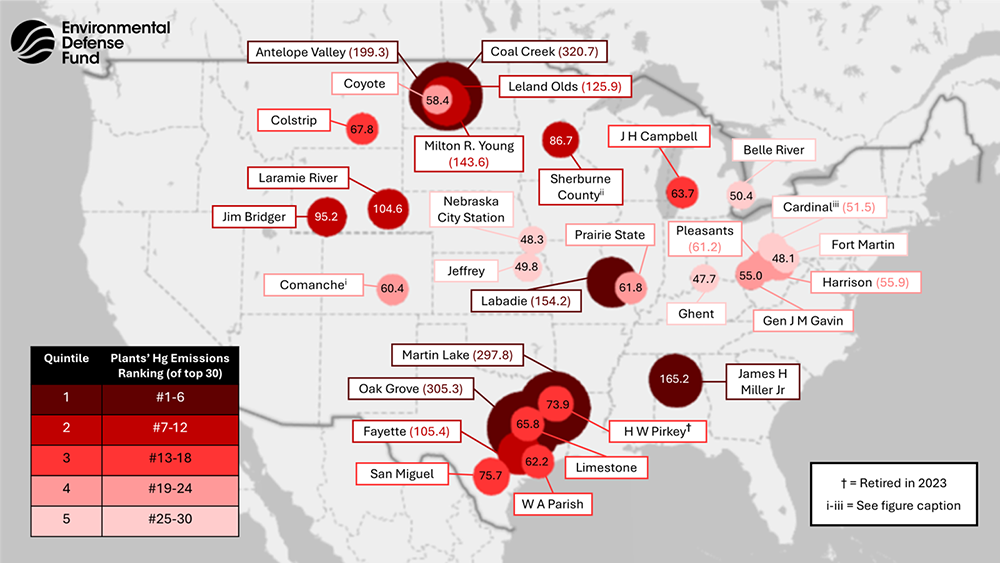This resource has been factchecked by policy experts, using the latest scientific research. Find all our sources linked below.
What is mercury?
Mercury may be naturally occurring, but this heavy metal is highly toxic and dangerous, especially for children. In the U.S., the biggest source of mercury pollution is coal-fired power plants. The small quantities of mercury in coal get released into the air when it’s burned for energy. From there, mercury falls into waterways like rivers and lakes and enters the food chain.
In aquatic ecosystems, microbes convert mercury into methylmercury. This accumulates in fish. Methylmercury concentrations in fish can be exponentially greater than in water. When humans eat fish, which is widely thought to be a healthy food choice, mercury gets into our bodies too. But there is no safe level of mercury consumption. This is why pregnant people are specifically warned to avoid eating too much fish; mercury can cause severe damage to developing babies’ brains.

How does mercury affect health?
Mercury can have a wide range of impacts on human health, impacting the brain, kidneys, and lungs.
When pregnant women eat contaminated fish, it can sail across the blood-brain and placental barriers after ingestion, leading to toxic effects on developing fetal and infant brains. In addition to being a powerful neurotoxin, mercury exposure during pregnancy can also cause disrupted motor function, learning impairments, and behavioral problems in children later in life.
In adults, mercury has been linked to neurological and cardiovascular harm, including increased risk of heart attacks, as well as endocrine disruption, diabetes risk, reproductive harm, thyroid dysfunction, and compromised immune function.

Mercury and fish consumption
Although fish can be a low-cost source of protein and nutrients, there may be long-term health harms from eating fish contaminated by methylmercury—and not just for children. People who eat fish more frequently, like recreational or subsistence fishers, are at higher risk for experiencing health impacts from mercury. There are many fish consumption advisories due to mercury contamination in water bodies across the United States, usually listed by individual states. It’s wise to heed them, especially when pregnant.

Mercury protections in the United States
Families need protection from dangerous coal-plant mercury pollution. Congress began protecting people from this pollution from electric utilities through the 1990 Amendments to the Clean Air Act. In 2012, the Environmental Protection Agency (EPA) finalized the Mercury and Air Toxics Standards (MATS). MATS put in place national pollution standards for coal- and oil-fired power plants, which have been highly effective in reducing mercury pollution and protecting human and ecosystem health.
MATS also regulates other hazardous air pollutants, like lead, arsenic, dioxins, acid gases, and cancer-causing chromium, nickel, and selenium. Since MATS was implemented, mercury emissions are down 86%, acid gas hazardous air pollutants have been cut by 96%, and non-mercury metal hazardous air pollutants have been reduced by 81%, according to EPA data.
While mercury controls have been largely successful, much work remains to be done. There are still many coal plants in the U.S. releasing significant amounts of mercury into the air, putting families’ health at risk. Lignite coal, for example, is considered the most polluting and health-harming form of coal, and there are lignite plants in operation, predominantly in Texas and North Dakota, that are among the worst mercury offenders.

The strength of MATS standards depends largely on who is in office. For example, in late 2020, the first Trump administration worked to undermine mercury standards, and his EPA finalized a change to MATS that withdrew the legal justification for the rule, known as the “appropriate and necessary finding,” putting the standards at risk. Then in 2023, the Biden administration’s EPA restored the finding.
In 2024, Biden’s EPA finalized enhanced protections to MATS—the strongest version of the rule yet, including closing a loophole that allowed lignite plants to operate under weaker protections than other forms of coal. The fate of this important upgrade is at risk under Trump 2.0.
Mercury and community impacts
The dangers of mercury and other forms of power plant pollution are not distributed evenly. Communities living near coal-fired power plants—which are disproportionately historically marginalized communities of color and socioeconomically disadvantaged communities—are among the most at risk from power plant pollution. Because many Indigenous peoples rely on locally caught fish for food and cultural identity, mercury pollution disproportionately harms the health of Tribal communities.
Get involved
We cannot afford to reverse direction on recent progress. Join Moms Clean Air Force in telling EPA to maintain the strengthened Mercury and Air Toxics Standards and not to undo the upgrades that protect our families, our environment, and the air we breathe.
Learn more about Moms’ work on mercury pollution.
Full list of sources.
Updated: April 2025




